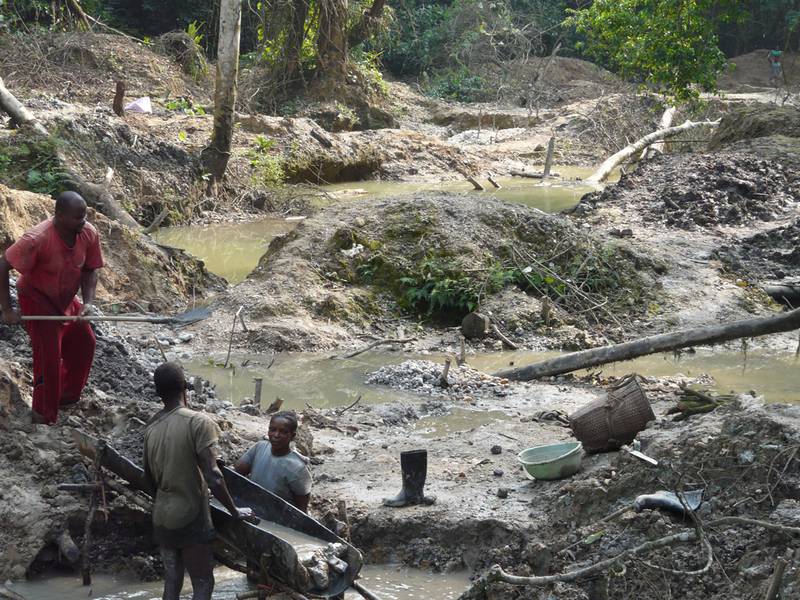Maiko and the Simba
Categories: Journal no. 43, Threats, Protective Measures, Democratic Republic of the Congo, Maiko, Grauer's Gorilla, Gorilla Journal
The Maiko National Park (MNP) is one of the least known and most biodiverse of all parks in the Democratic Republic of the Congo comprising over 10,000 km² of lowland rainforest towards the easternmost limits of the Congo Basin. It is also unique within the country's protected area framework of biological representivity and is the only national park in DRC to contain three of the country's most important endemics: the Grauer's gorilla, the okapi, and the Congo peafowl (Amsini et al. 2005; 2006; Braum & Mufambule 2008). The park also contains significant and viable populations of elephant, chimpanzee, bongo and leopard (Hart & Sikubwabo 1994). Despite this significance, the park has received little national or international attention or management support since its creation in 1970, effectively existing only on paper. The Maiko forest also constitutes a vast carbon sink, and its protection is of global importance in preventing further climate change.
Due to the park's inaccessibility and remoteness, the forest block remains a bastion for a group, known as the Simba Mai Mai, who took refuge there in 1964 after the assassination of Prime Minister Patrice Lumumba. Refusing to accept or acknowledge the legitimacy of the Mobutu regime, the Simba have remained in the park ever since, making a meager living from the park’s resources and protecting it from other rebel groups fighting in the region.
Excluded from the Sun City Peace Agreement in April 2002, because they were considered to be an "internal problem", the Simba were eventually given a voice and a platform at the National Amani Peace Agreement in January 2008. Along with many other internal rebel groups, they agreed to demobilise as part of the national movement towards peace and stability within the newly established framework of democracy, the process which was officially launched by Congolese Government and the United Nations on the 6th May 2010. This provides a unique opportunity, for the first time since the park's creation in 1970, to resolve the issue of Simba rebels in the park and ensure the long-term protection of one of the world’s last intact forest frontiers.
However, the group's basic demands to support reintegration into civil society after nearly half a century living in the forest have not yet been met by the Congolese government. The Frankfurt Zoological Society is about to launch an initiative, with funding from the German Government, to support the development of social and economic opportunities for those Simba Mai Mai and their families returning to a normal life outside the park.
The project will make significant contributions to the well-being of the Simba community. Over the next 2 years we will be working with local authorities to support the voluntary resettlement of the community and will be providing building materials for new homes outside the park. A purpose-built school and health centre staffed by government employees will ensure that their children have the necessary access to health and education, thereby improving their physical and social capital. Support will also be provided for business and technical skill acquisitions, and for the development of pilot micro-credit programmes for conservation compatible and environmentally sustainable small business enterprises to improve the Simba community's economic capital and reduce forest dependency.
Land-use planning and participatory zoning schemes will help limit development activities to those areas of least environmental concern and importance, while training in improved agricultural techniques will improve productivity and yield of land set aside for agriculture. Support for the use of alternative energy sources and fuel-efficient stoves will also be provided in an effort to greatly reduce fuel-wood consumption at the household level, thereby significantly reducing rates of deforestation and degradation and improving environmental sustainability.
This project will greatly enhance the protection of Maiko National Park by giving members of the Simba Mai Mai community the opportunity to join the park’s ranger force. The recruitment of 30 young men will enable the Congolese wildlife authority to benefit from their superior knowledge of the park, while providing long-term employment opportunities to the Simba in a region of virtually zero employment. The Simba community's remarkable history is intimately linked with the presence of Maiko National Park, and its continued existence today may be in part due to their long-term occupation of the forest and protection of its resources from external pressures. Frankfurt Zoological Society will be working to ensure that the Simba are now able to play a role in the future of the park while benefiting from the stability of reintegration into society.
Robert Muir
References
Amsini, F. et al. (2005): Identifying conservation priorities for the recovery of the Maiko National Park, post-conflict surveys of wildlife populations and human impact in the North Sector of the park. IMU Technical Report No. 4. Wildlife Conservation Society, New York
Amsini, F. et al. (2006): Identifying conservation priorities for the recovery of the Maiko National Park Part 2, post-conflict surveys of wildlife populations and human impact in the southern sector. IMU Technical Report No. 6. Wildlife Conservation Society, New York
Braum, D. M. & Mufabule, K. (2008): Biodiversity Surveys of the Maiko National Park and UGADEC Community-based Wildlife Corridor, Eastern DR Congo, Distribution and status surveys of Grauer’s gorilla Gorilla beringei graueri and other wildlife
Hart, J. A. & Sikubwabo, C. (1994): Exploration of the Maiko National Park of Zaire 1989–1992: History, environment and the distribution and status of large mammals. Wildlife Conservation Society, New York

